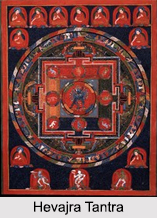 Non-Duality in Hevajra Tantra consists in the polarity of the absolute between the active and the passive, the positive and the negative. A number of tantric theoretical assumptions have contributed to the formation of the Vajrayanic theory and subsequently of the Hevajra Tantra. It has inherited from the beliefs of Mahayana Buddhism. In Vajrayanic belief, the most vital concept seen is of the Absolute as being bipolar in nature. In Mahayanic beliefs, it is considered as constituting the two polarities within the Absolute, and these two polarities are viewed as female and male.
Non-Duality in Hevajra Tantra consists in the polarity of the absolute between the active and the passive, the positive and the negative. A number of tantric theoretical assumptions have contributed to the formation of the Vajrayanic theory and subsequently of the Hevajra Tantra. It has inherited from the beliefs of Mahayana Buddhism. In Vajrayanic belief, the most vital concept seen is of the Absolute as being bipolar in nature. In Mahayanic beliefs, it is considered as constituting the two polarities within the Absolute, and these two polarities are viewed as female and male.
Another very important perspective adopted herein is that the body is the microcosm and hence the abode of truth. The truth is realised within the body through direct personal experience known as "Swasarivedyam". The realization of the absolute, is believed, leads a person to have a "homologous vision" of the world. These are the primary principles that have influenced the tantric principles that constitute the Hevajra Tantra.
Nature of the Non-Duality in Tantrism
The most basic tantric principle of Hevajra Tantra is the non-dual nature of reality. Reality is seen as being bipolar. The fundamental principles of Tantra assert two main things in keeping with diametrical polarity:
i. Everything is "conjunctio oppositorum", and
ii. In everything there is a built-in polarity, which may be expressed in terms of positive-negative, potential-kinetic, thought-action, intelligence-emotion, male-female, etc.
It is perhaps this insight which led to the belief that ultimate reality is Bipolar. The Nature of Non-Duality according to various beliefs is discussed below:
Tantra in Hinduism and Tantra in Buddhism both assert that there are two aspects to ultimate non-duality: the positive (pravitti) and the negative (nivitti), the static and the dynamic. These two aspects are found in Hinduism in the form of Shakti and Shiva.
In Buddhism these are represented by Prajna and Upaya, also known as Sunyata and Karuna. These are the principles of passivity and activity respectively. The former is comprised of Dharmakaya, while the latter comprises the whole world, Sambhogakaya and Nirmdnakaya. These two are considered to be the manifestations of Karuna, as they are meant to lead all beings towards the ultimate goal. The relationship between the Prajna and the Karuna is such that they are different yet inseparable. This concept of the Ultimate Reality is a metaphysical necessity and not just a theological principle. The noumenon in Vajrayana, must have some principle of self diversification, and contain the germ of everything phenomenal. It must therefore be both passive and active.
The Mahayanic principles believe that phenomena are not something which is integral to Sunyata, but on the contrary something thrust on it from above. The bi-polarity is a tantric attempt to bridge the gulf between the Absolute and the relative (paramartha and samviti) - a unique way to accommodate the empirical.
In the Madhyamika, the bi-polar nature of the non-dual is foreshadowed by the conception of "Bodhichitta" as the mingling of the Sunyata and Karuna. This polarity is not understood in the tantric sense.
Thus the bi-polarity of non-dual reality is expressed in such compound terms as, Sunyata-Karuna, Prajna-Upaya, Lotus-Jewel, Ghanta-Vajra, Sun-Moon, Ali-Kali, Lalana-Rasana, Dinam-Naktam, etc.









